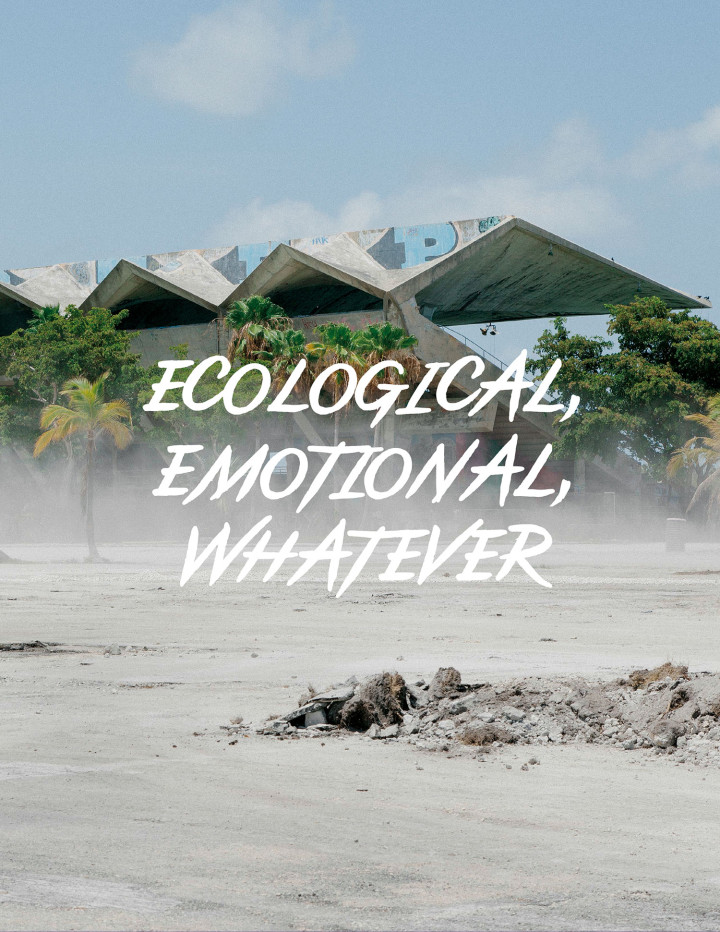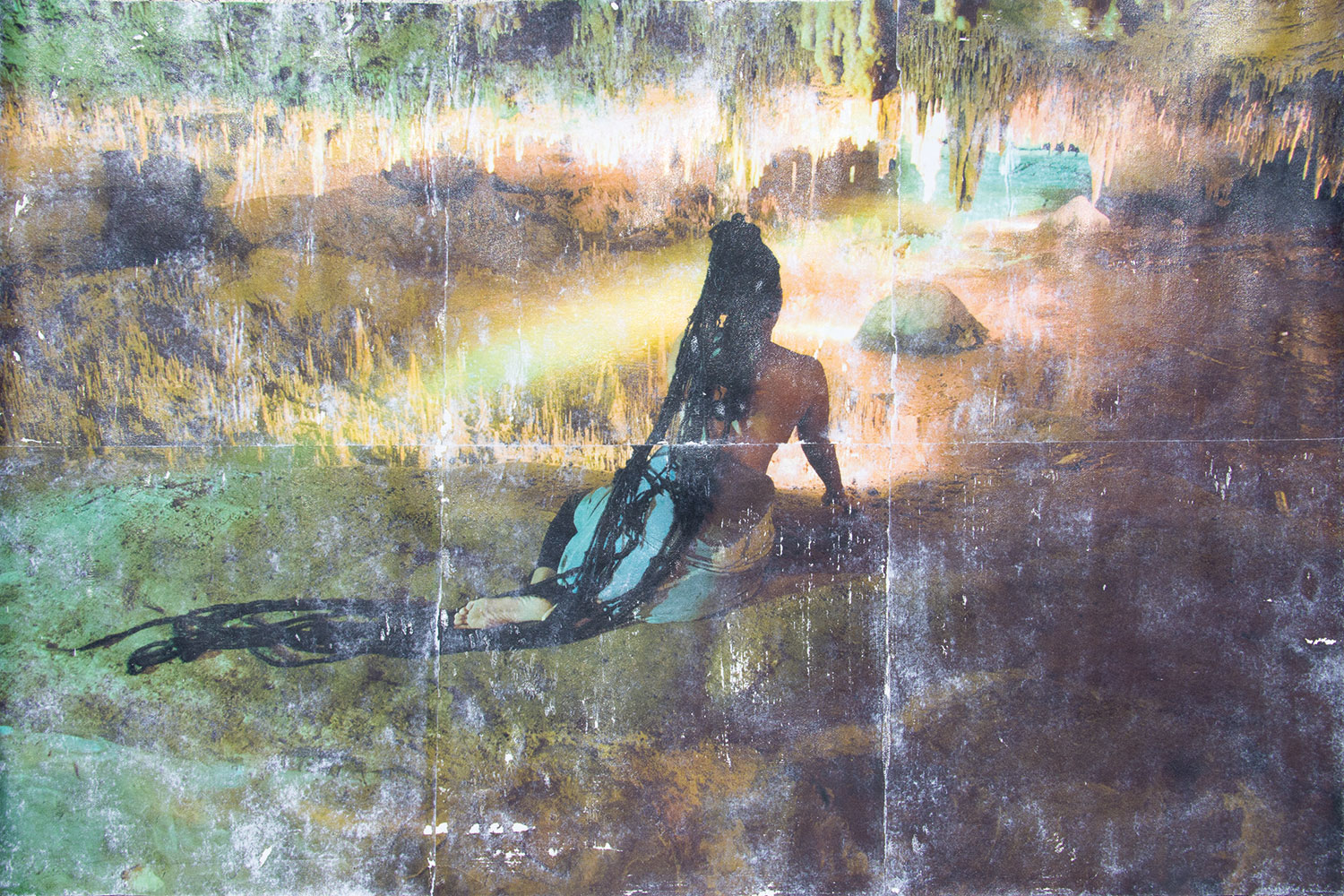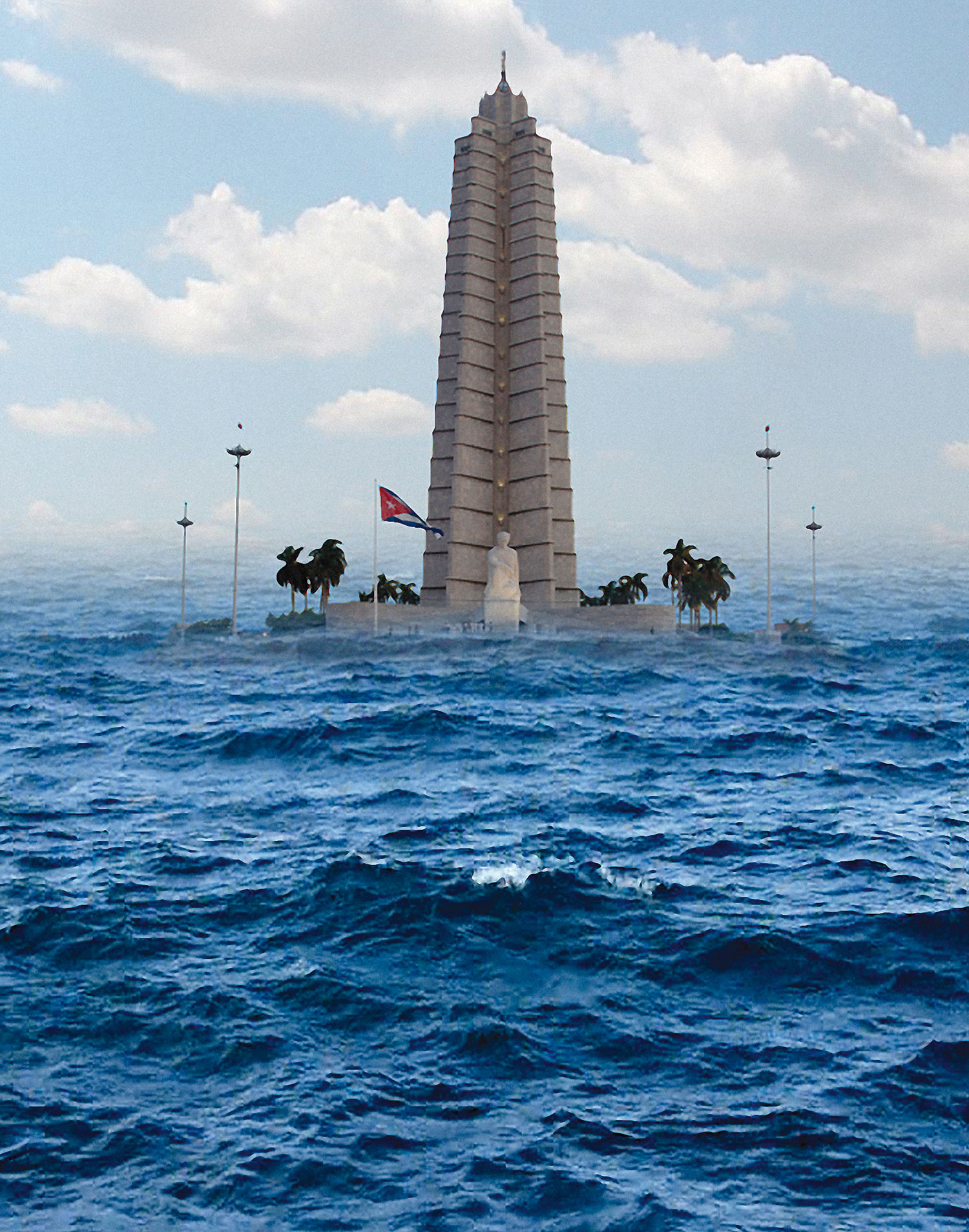
Laura Mclean-Ferris: To begin this discussion about pastoralism, I’d like to ask about your most recent body of work, which draws on the idea of the “pioneer woman,” specifically in certain depictions from 1990s television. Can you describe these recent works and your interest in this kind of feminine archetype from the media?
Dena Yago: There was a show on the Outdoor Channel that aired around 1999, The Huntress. In one episode, the host — Heidi Wilson — goes hunting for squirrel with her son. The show quickly segues into a cooking show where she prepares her son’s kill into “squirrel melts.” With The Huntress, homemaking is expressed in its traditional forms, through hunting, killing, cooking. I’m interested in Wilson’s proximity to violence and the subsumption of that very direct violence into an expression of care, love and home making. Or in how direct aggression, through one step of removal, quickly becomes an act of maintenance, of sustainability.
Recently I’ve become aware of people evaluating their art practices and lifestyles in terms of whether it “functions as a sustainable model.” In the way I see it being used, it’s less about sustainability in terms of avoiding the depletion of natural resources, and more about depleting just the right amount and setting up a very complex system of equivalences (i.e., the cost of therapy equals a gym membership or the framing of a photograph; my internet use equals a case of wine). A “sustainable model” hints at a sense of responsibility for something larger than oneself, though it’s rarely used to refer to anything beyond the individual.
LMF: That’s true of these complex equivalences. I wonder if these strategies are also about buying time in an abstract sense. I used to have a part-time job at the Environment Agency in the UK, and sustainability was one of the main development concepts used at that time. It also seems that the “sustainable model” is used to discuss certain art practices that are at risk of burning up in a speculative economic climate — sustainability as a counterpoint to market-driven speed, something like the ethos of the slow food movement.
Food carries a complex value system in relation to the land. In preparing for this conversation you sent me an article on Alice Waters, known for founding the restaurant Chez Panisse in Berkeley, in 1971, and largely spearheading the organic food movement on the American West Coast.
DY: George Packer’s article on Waters, “Radish Queen,” was included in his book The Unwinding: An Inner History of New America (2013), which charts a history of deindustrialization in the U.S. through profiles of individuals like Waters. Chez Panisse opened at a time when affluent and middle-class Americans were eating either frozen dinners or French cuisine. That’s no longer the case, but produce and fresh foods are still pretty unaffordable to the general public — there aren’t many affordable options for unprocessed foods to those that are strapped for time and cash. When you do see some solutions to these issues, they’re often framed as clickbait, such as “Ten Easy Ways to Pack a Healthy Lunch” or “life hacks.” Alice Waters and the chefs at Chez Panisse would famously forage alongside railroad tracks to source greens. But you need more than just resourcefulness; you have to have time. Writing about a relationship to food and time can become a stand-in for talking about class and social relations.
LMF: It’s clear that certain aspects of health and well-being fall under the heading of “luxury,” because they require time and money, but healthiness has an even more distinctly stratified marker of class than ever before, because the signs of its display are more subtle. Growing one’s own vegetables or going to the farmer’s market can be read to signify a higher class status than going to Whole Foods does because, perversely, it’s more difficult and requires more time and effort. Thornsten Veblen in The Theory of the Leisure Class (1899) describes the idea of the pastoral as “rural” literature and art that develops in the midst of a crisis about urban values. The artifice of a pastoral past (back to the land) and the fictions that it draws upon and perpetuates are undergoing something of a resurgence — moving to Upstate New York, or even moving to somewhere like Greece (rich in soil, produce, history; poor in economics in terms of a modern global economy).
DY: When affluent people move to Hudson or Greece, a lot of these lifestyle decisions are framed as “retreats” — whereas you might refer to places that are ripe for foreign real-estate investment as “escapes.” There is something to go back to, and it’s implied that these retreats are temporary. Motivations for moving to these places are different from those of groups like the Greenhorns in the Champlain Valley of New York, who work as farmers and advocate for young farmers across America. The former falls under what Sean Monahan and I recently talked about for a K-HOLE talk at the ICA Miami, the concept of “Survivalist Cos Play,” which is an act of performing one’s ability to survive. Or performing self-sufficiency and demonstrating that one could live outside of the systems of capital that they’ve wholly bought into, or in a post-apocalyptic world. We used Naked and Afraid and Barry’s Bootcamp as examples, but many urban farming projects (within cities, not outside of them) fall under this category.
LMF: How do you think that that pastoralism is used to affirm or deny certain realities today?
DY: The pastoral tradition in art and literature often deals with social order, and clearly delineates the borders of an urban and cultured experience. The position of many of the artists working in this tradition has frequently been distanced — romanticizing the farmer, the shepherd, the huntress, without getting one’s hands dirty. In some ways the pastoral as it existed at the birth of the industrial revolution served as a reminder that the spaces outside of industrialized cities still existed. It also functioned as a way for the leisure class to distance themselves from industrial workers; they instead identified with agrarian laborers, whom they deemed pure and natural.
But pastoralism becomes something else when the only remaining frontier is ourselves, which we then in turn cannibalize — all while still using the totems and iconography of the period of expansionism, when the rural and the frontier were vast expanses of land to homestead. The most direct example of this would be restaurants that source ingredients from their rooftop gardens while decorating their sustainably designed interiors with reclaimed wood and small wood-burning stoves, all the while mood-boarding their menus and websites with images from “The Source” era of communalism in the late 60s.
LMF: Can you expand on what you mean by this “human frontier” you reference?
DY: I mean more that an expansionist view has turned inward; the space we’re left with is more about making space within already populated landscapes. As in, figuring out how to make space for a community in an untenable environment that one has willingly chosen to inhabit. On the individual level, an example might be how our vision of a modified futuristic human body was more based on external prosthetics, whereas now it’s less visible, more about performance-enhancing brain and body hacks.

LMF: I’m interested in the way that several of your works tend to problematize constructions of the rural or natural as artificial, and vice versa. In Venkatesh Rao’s essay “The American Cloud” (Aeon, July 2013) he outlines the way that the contrasting economic visions of Thomas Jefferson and Alexander Hamilton have come to overlap in contemporary America. He describes certain artificial constructions — such as the farmer’s market design-feel of Whole Foods — as giving the consumer an “emotional satisfaction” for which they are prepared to pay. How do you conceive of this emotional power and its application?
DY: Rao speaks of how we skin the back ends of American commerce and infrastructure (which he refers to as “Hamiltonian cathedrals”) with a thin film of craft-oriented and “emotionally satisfying” visual cues (which he terms “Jeffersonian bazaars”). As an example, he brings up the design of Whole Foods, which tries to feel more like a farmers market, less like a Costco. Constructions like this are by no means new, and the iconography of expansionism, rural life and the American West have long become an established design aesthetic. It’s this aesthetic of homesteading that interests me, whether it’s looking to craft or the use of mechanical tools or rusted domestic objects. This aesthetic is often used to imply intimacy and the presence of a community, which is pretty suspect. I’m interested in what the habitats of occupied communal space look like — not in a broader ethnographic way, but in my immediate surroundings. I continually photograph and work with materials from my domestic life, while simultaneously photographing sites like Pioneertown in Yucca Valley, which was built in the 1940s as a live-in film set.
LMF: Your work has also focused on cohabitation with animals. There’s often a suggestion of a gray zone between intimacy and dependency — or violence and care. For the exhibition “You and You’re People” at BFA in São Paulo in 2014, you showed photographs of dogs taken at a dog park strung with aluminum text pieces taken from the chapter titles of Rainer Werner Fassbinder’s series Berlin Alexanderplatz (1980), such as “The Sun Warms the Skin, but Burns it Sometimes Too.”
There is a sense of a strictly boundaried existence of submission that amounts to a lack of freedom for both animals and their owners, which is nonetheless a form of love and care. Have you developed such slippages formally in the work?
DY: I’ve photographed domesticated animals, such as dogs and their owners in dog parks, and then I’ve photographed the animals of cities like New York City and Los Angeles. I think of animals like squirrels, pigeons and ducks as cohabitants in a city. You have certain similarities between groups; talking about pigeons can quickly turn into a conversation about artist communities. For instance, both groups are used as icons of the city (pigeons signifying urbanity and artists signifying New York City as the creative capital of the world), though the city creates “proper” representations of both and renders all others invisible. Both groups thrive on hostility.
Photographing dogs in a clearly delineated and enclosed space of leisure, the dog park, you quickly see social relations played out. These photographs are of relationships — between dogs, between dogs and their owners. There was a photo of a chow who had a collar tag that read “Have Your People Call My People.” I didn’t notice this until afterwards, but it sums up a lot of things I’m discussing in that work: subservience, deferral, care and control. The tag led to the title of the exhibition. The distinction between violence and care can be read in subtleties — shifts in body language, changes in the conjugation of words and pronoun usage.

LMF: And how does that relate to your ideas about care in the work? In your writing, your poetry, your work with K-HOLE and your art practice, you explore cohabitation and collaboration. How has your own understanding of the way intimacy evolves among friends and peers changed, and how do you see this relating to something like gentrification or a sense of place? Can you describe your sense of a practice that is dispersed among a community?
DY: One way that I see this cannibalized pastoralism existing within art is with the romanticization of artistic communities. Artists are known for living in totally collapsed social spheres and having messy relationships in which people play every role in one another’s lives — friends, lovers, collaborators, gallerists, therapists, art dealers, drug dealers, interns, family. In a loosely tied, disembodied network of 1099’ers and artists with day-jobs, I think that different kinship models provide some sort of alternative to the atomized, isolated “cooking for one” life that is encouraged. I’m interested in relationships of kinship and care, and bonds between people that choose to cohabitate spaces, and in how in these kinships you slip into and out of shared spaces of intimacy. In many ways you make these chosen families out of a survivalist urge; it’s a circling of the wagons. In terms of how this relates to gentrification, the nature of some of these kinds of communities are based on exclusivity, and by making space within an already occupied landscape it’s rare that you’re not edging other communities out in the process.
LMF: The exhibition “Heat Island,” held in 2014 at Gasconade, Milan, was attentive to the climactic conditions of a hot, busy metropolis such as Manhattan, where plants such as figs, usually requiring warmer conditions, can grow due to the heat of buildings and people and all their energy and labor. I suppose that this is why your work has occasionally been positioned within a discourse about the Anthropocene. How do you think about that discussion, which has gained a lot of traction in the past five years or so?
DY: The heat island effect is a rising in ground temperature due to population density, but that is just one of many environmental aberrations that exist in a city like New York. Other aberrations can be seen in people’s behavior, how communities are formed, what relations exist within those communities, and how they emerge out of hostility. For a certain type of artist, living in these environments can breed complicity. Survivalism largely precludes critique. They are both affecting their environments on a geological scale while being products of their environment that they’ve created as a collective whole or bought into as individuals.





